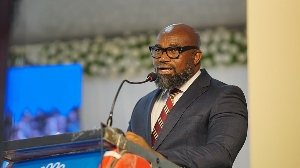- Home - News
- TWI News | TV
- Polls
- Year In Review
- News Archive
- Crime & Punishment
- Politics
- Regional
- Editorial
- Health
- Ghanaians Abroad
- Tabloid
- Africa
- Religion
- Election 2020
- Coronavirus
- News Videos | TV
- Photo Archives
- News Headlines
- Press Release
Business News of Thursday, 5 December 2013
Source: B&FT
VRA assessing wind-power sites

The Volta River Authority (VRA) has begun the search for the most suitable location in the country for construction of a 100-150 megawatt (MW) wind-farm.
Spanish company Barlovento Recursos Naturale has been engaged by VRA to assess eight sites, including the coastal towns of Winneba, places between Ada and Keta, as well as the inland towns of Techiman and Gambaga in the Brong Ahafo and Northern Regions.
VRA’s Senior Electrician Engineer Ebenezer Kojo Antwi told B&FT Barlovento has since last month begun measuring the wind power density (WPD) of different sites to determine the best locations for wind energy development.
Wind power density is a calculation of the effective force of the wind at a particular location, frequently expressed in terms of the elevation above ground level over a period of time. It takes into account wind velocity and mass.
The measurement, Mr. Antwi said, will last between 12-18 months, after which the company is expected to submit the results of its study to the power generation company.
The project, which is a joint venture between the Authority and private partners, will cost about US$350million if successfully established.
“There are advantages to renewable energy which the country has to explore. In the past, drought and fuel hikes have exposed the disadvantages associated with hydro and thermal,” Mr. Antwi said.
The VRA’s venture into renewable energy has become prudent because the cost of production has fallen considerably.
The company’s Director of Engineering, William Sam-Appiah, commenting about the development told B&FT the investment is in line with the National Energy Policy to diversify the country’s energy portfolio to include renewables.
The VRA, with a total installed capacity of 2,100 megawatts (MW), generates about 1,600 megawatts of electricity -- both hydro and thermal -- every day.
The Renewable Energy Act (Act 832), passed in 2011, is targetting at least 10 percent of the country’s total energy supply to come from renewables -- sun, wind and biofuels -- by 2020.
According to Mr. Sam-Appiah, it is possible that the 10 percent target could be surpassed based on the planned investment. “Initially, we said we were doing 10 megawatts of solar and 100-150 megawatts of wind energy, but that figure could go up. To date, we have two megawatts of solar and are expanding to 12 megawatts with funding from KfW, a German agency.”
The Public Utilities Regulatory Commission (PURC) in collaboration with the Energy Commission and Ministry of Energy and Petroleum recently operationalised the Renewable Energy Feed-in-Rates scheme to encourage investments in the sector.
The feed-in-tariff scheme guarantees a fixed price at which power producers can sell renewable energy into the national power grid.










